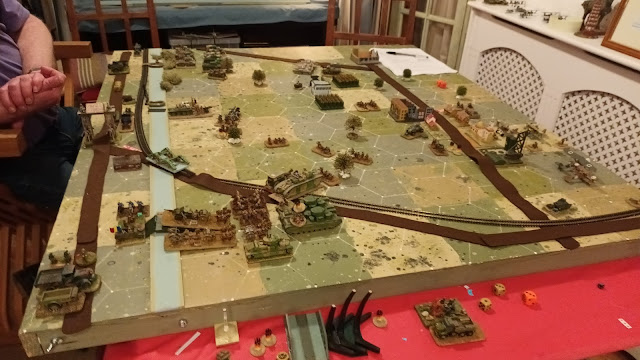Chris provided this week's entertainment. He's moving NQM onto hexes, having previously gone from open to squares. Nicely done hand drawn hexes on the table, I think you'll agree. The scenario was 1934 eastern Europe with Soviet and Fascist proxies facing off (Paprika v Tibia respectively) with the Paprikans invading.
Chris set up a game with Jon F as on-line commander of the invading forces, instructing Tim & Steve, with Phil & me as the defenders. The Paprikans had overwhelming force, so Phil and I would be on our mettle. Alas before we started Jon called in sick, having done his back in whilst wargaming the previous day. Damn, this is a dangerous hobby.
The Paprikans had a lot of kit:
They were coming on from the top of the board, and had to cross the river. They had a few bridge laying elements.
We had slightly fewer troops:
We would obviously need to be cunning in the extreme.
My photo record is incomplete, as is often the case if I'm playing not umpiring.
Phil and I deployed forwards with the infantry on his flank, and then had a mobile reserve to deal with other threats. As they swarmed across the river, the armoured part of the reserve was soon in operation.
Alas there was even more enemy armour on Phil's end of the table. Phil had blown the main bridge, but the Paprikan bridging units more than compensated. Phil's infantry put up stiff resistance, backed by the Divisional artillery.
The sheer weight of numbers was forcing me back. I deployed our infantry reserve to Pico Blanco. We are suffering as we are spread wide and only have one LOG and MEDIC unit between us. They're currently up on Phil's flank, trying to keep him in the game.
Phil is under a lot of pressure from tanks, artillery and cavalry. He's already lost our Divisional artillery.










In Wargaming, unseen hazards are lurking everywhere. Too bad I had to bail but my back was killing me.
ReplyDeleteStabbing myself with little metal pikes when I put a hand on a unit in error is etched in my memory.
DeleteThat looks fantastic - and I like the interwar concept. I recall seeing someone's war game of the brief war between Hungary and Czechoslovakia (1938). The name Paprika for one of the belligerents put me in mind of that game.
ReplyDeleteThe hex grid looks great!
Chris creates a particular kind of aesthetic with his games. It helps that he's both an engineer and an artist. When he said Paprika to me I thought of the army as a Hungarian proxy at first, then I realised he has them the wrong way round if that is the case.
DeletePresumably paprika is"red". Tibia is some sort of body part. The brigade of breakthrough tanks is grand, very Plan 1919.
DeleteThe Paprikans were the Soviet proxy for sure, so it fits for that and also being near Hungary. Why "Tibia" was chosen I can't say. It's a change from the Ribeanans, who have popped up in Chris' games before.
Delete